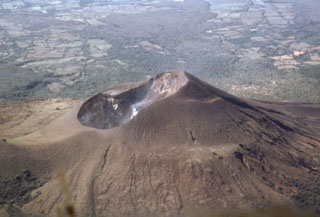Report on Telica (Nicaragua) — 3 January-9 January 2007
Smithsonian Institution / US Geological Survey
Weekly Volcanic Activity Report, 3 January-9 January 2007
Managing Editor: Sally Sennert.
Please cite this report as:
Global Volcanism Program, 2007. Report on Telica (Nicaragua) (Sennert, S, ed.). Weekly Volcanic Activity Report, 3 January-9 January 2007. Smithsonian Institution and US Geological Survey.
Telica
Nicaragua
12.606°N, 86.84°W; summit elev. 1036 m
All times are local (unless otherwise noted)
On 9 January, INETER reported that a gas-and-ash plume from an eruption of Telica reached an altitude of 1.5 km (4,900 ft) a.s.l., drifted W, and then reached a greater altitude. The eruption was accompanied by increased seismic activity. The Washington VAAC reported that a possible ash plume was visible on satellite imagery and on a web camera, drifting SW.
Geological Summary. Telica, one of Nicaragua's most active volcanoes, has erupted frequently since the beginning of the Spanish era. This volcano group consists of several interlocking cones and vents with a general NW alignment. Sixteenth-century eruptions were reported at symmetrical Santa Clara volcano at the SW end of the group. However, its eroded and breached crater has been covered by forests throughout historical time, and these eruptions may have originated from Telica, whose upper slopes in contrast are unvegetated. The steep-sided cone of Telica is truncated by a 700-m-wide double crater; the southern crater, the source of recent eruptions, is 120 m deep. El Liston, immediately E, has several nested craters. The fumaroles and boiling mudpots of Hervideros de San Jacinto, SE of Telica, form a prominent geothermal area frequented by tourists, and geothermal exploration has occurred nearby.
Sources: Instituto Nicaragüense de Estudios Territoriales (INETER), Washington Volcanic Ash Advisory Center (VAAC)

